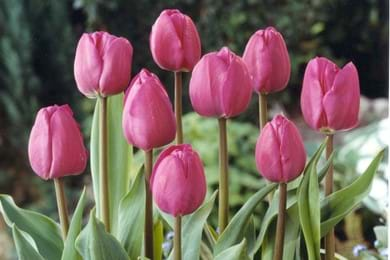
Tulip
Instructions for Tulips treated at 5°C
Upon arrival the skin needs to be removed. The brown skin around the rooting ring is the most important part to be removed. The bulbs might already be peeled by the supplier, but if not, do this by hand with a knife or a plastic fork. While peeling, do check at the same time if bulbs are infected by fusarium (sour smell) or other bulbs diseases.
If planted in boxes:
Put about 4 to 5 inch of a potting mix in the bottom of the crate. Be sure that the soil is already moist. Plant the bulbs after being dipped for 20 minutes in a Captan/ Benlate or Chipco/Cleary's mix.
For the regular Triumph varieties plant 55 to 60 bulbs per crate. French types plant 25 to 35 bulbs per crate.
If planted in pots generally 5 bulbs (Size 12/+) are being used for a 6" pot and three bulbs for a 4 or 4.5" pot. Put about an inch on top of the bulb. After this is done, give it a good soak of water to be sure that the entire crate is well moist to wet.
Early in the tulip season (October) the weather can still be warm. If so do pre-root in a cooler at 48°F. After they get started and have about 1 to 2 inches of roots, you can move them into the greenhouse. If cool enough weather (average of 50°F or cooler you can go directly outside). Ideal temperature is 45°F to 48°F. Be sure that after putting them in the greenhouse to give them another watering, either by drip or with a hose.
Going into November the outside temperatures are dropping and you can move them in the greenhouse directly.
Vent the greenhouse as much as possible. Venting will prevent sweaters and stem topple and increase calcium transport inside the plant. When you water add some calcium to the feed. Tulips like to get about 1.5 to 1.8 EC. Temperature in the greenhouse needs to be cool (55° to 60°F) and plenty of ventilation. They perform better with more length and strength when grown at cooler temperatures.
Day time temperatures try to keep them at 62° to 65°F. Night temperatures try to keep at 45°F to 55°F.
Spray the tulips against Botrytis Cinerea (Spots) ones every 10 days. If you see spotting on the flower increase the frequency. Chemicals like Chipco, Degree, and Daconil will work fine. Try to avoid Daconil or Chipco when flowers start to show color. It will affect the color.
During growing, always check the rooting. If you have a good root established the rest of the crop should go well. If you do not see good roots several reasons can be the cause:
- Higher salt levels
- Dry soil mix
- Too wet of a soil mix and not enough air
- Bulbs that have not received their full cold treatment and therefore poor rooting
- Infected soil
Instructions for Tulips treated at 9°C
For these tulips, the skin does not need to be peeled. Ask your supplier for the cooling requirements. Most of the cooling will be done at your facility. The bulbs need to be planted upon arrival and cooling should get started right away. There are different temperature treatments for the time span that you give these bulbs cooling.
Check your coolers regularly so that the coolers do run at required temperatures. Less soil in the crates/pots is required when the Tulips are 9°C treated. Put about 1 inch of soil on top of the bulbs after planting.
If longer stored in the coolers shrink wrap the pallets to prevent drying out of the crates/pots.
Keep the ground in the cooler wet by dumping a bucket of water each morning on the floor.
When bringing the crates or pots in the greenhouse do that on a day where the weather is not too warm. Give them a good watering right away.
If Bonzi is applied for pot culture, drench the pots 2 to 3 days after bringing the pots into the greenhouse. Rates that are being used are 5 to 10 ppm. Generally one application is enough but depending of your location and variety you might have to get back in with a spray.
Flamingo Holland cannot be liable for any loss of profit, growing result or any other commercial damages resulting from use of this guide. This guide is for information purposes only and are not warranted for content, accuracy, or performance overall.